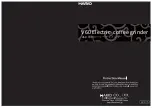
8
9
4. Fold the template along the edge of your cabinet so the thick line is straight
with bottom front edge; pull template tight and tape down to hold in place.
5. Drilling from under the cabinet up, drill holes through the 4 places marked on
the template, using a ¼-inch drill bit
(E)
.
Important: Always ensure you are drilling straight up through the marked
mounting hole on the template. Drilling at an angle may prevent proper
installation and may damage cabinets if the drill bit pierces the partition.
6. Once holes are drilled, remove tape and mounting template.
7. Wipe dust and debris off the topside and underside of the cabinet surface.
8. Place a washer inside the cabinet over each of the 4 holes you drilled.
Important: Top panel of coffeemaker is removable to make installation easier.
Simply grip the panel at the rear and pull back to remove (Fa) or insert a flathead
screwdriver at the front of the panel by one of the mounting holes and twist to
pop open (Fb). Once removed, mount panel in place following the directions
below and then slide coffeemaker back on the panel track to reattach appliance
once the panel has been mounted.
9. Hold panel in place; drilled holes on cabinet should be aligned with mounting
holes on the panel.
10. From inside of the cabinet down into panel holes, drop 4 screws in place.
Place a nut on each screw and tighten.
Note:
To determine which screws to use, you must have enough of the screw
exposed underneath the cabinet to properly thread the screw into the nut.
Note:
Always tighten nuts to ensure the appliance does not move or shake during
operation.
Caution: This appliance features a Save-A-Plug™ outlet receptacle to connect
smaller †SpaceMaker™ appliances such as the mini food processor / grinder or
can opener. Do not use this outlet for any other appliance!
Caution: When selecting a location for your coffeemaker, make sure you have
adequate room to reach the receptacle.
Note:
If you are connecting another †SpaceMaker
™
appliance into the Save-A-
Plug™ outlet, make sure you can easily unplug the appliance after each use.
DETERMINE CABINET TYPE
Prior to installation, determine if your cabinet has a flat bottom
(B)
or
an overhanging molding
(C)
. If your cabinet is flat, follow STANDARD
INSTALLATION; if the cabinet has an overhang molding, refer to OVERHANG
MOLDING INSTALLATION.
STANDARD INSTALLATION (FLAT CABINET)
Important: Always wear protective glasses or goggles to prevent injury when
drilling.
1. Clear countertop under installation area to avoid getting dust or debris on other
appliances or items. Open cabinets and remove contents to make mounting
easier.
2. Clean both the underside and topside of the bottom panel of the cabinet.
3. With cabinet doors open, place mounting template flush against the surface of
the underside of your cabinet, making sure to align thick line on template with
bottom front edge of your cabinet
(D)
.
Important: Do not align screw holes on template directly under the partition
between cabinets, as this will prevent you from installing the appliance properly.
Pay close attention to where the drill holes will be set so as not to damage your
cabinets during mounting. Drilling through your cabinet’s partition may cause
damage to cabinets and prevent proper installation.
D
E
B
C
Fa
Fb






































